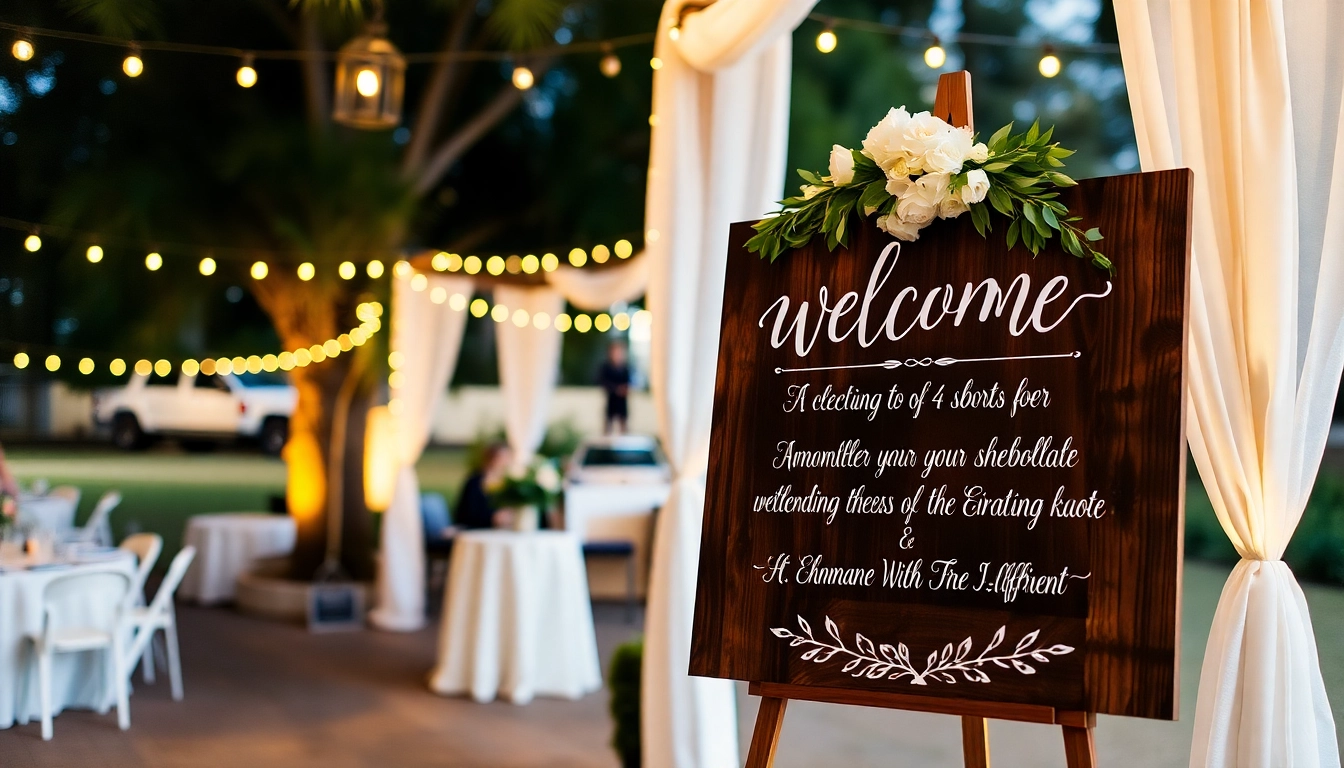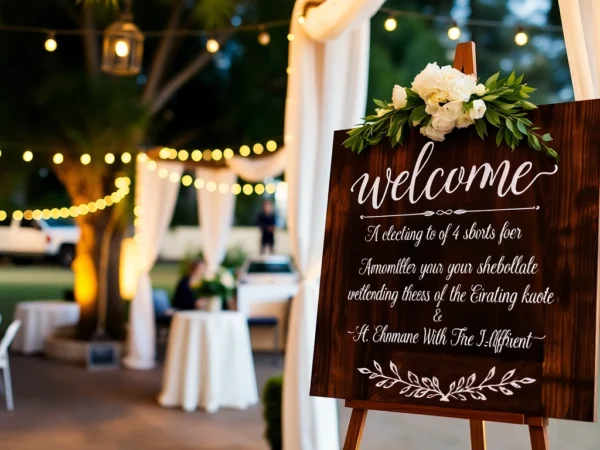Creative Wedding Welcome Sign Ideas to Make Your Entrance Memorable
Understanding the Purpose of a Wedding Welcome Sign
Setting the Tone for Your Wedding
The wedding welcome sign serves as the first point of physical contact between your guests and your celebration, functioning much like a warm handshake or a welcoming hug. It sets the initial tone of your event, giving guests a preview of the wedding’s style, theme, and atmosphere. Whether your wedding exudes rustic charm, modern elegance, or vintage sophistication, the design and message of your welcome sign should echo that sentiment. For example, a minimalist black-and-white sign with sleek typography can communicate modern chic, while a wood-framed sign with floral embellishments can evoke rustic romance.
Incorporating a personalized touch—such as a custom quote, a song lyric, or an inside joke—can immediately make guests feel connected and appreciated. This personal element helps create an intimate atmosphere and eases guests into the celebration, fostering a warm, welcoming environment.
Notably, the significance of the wedding welcome sign is supported by industry insights; with many couples choosing personalized signage, it directly influences guest engagement and overall event experience. In fact, a well-designed welcome sign can be the centerpiece that ties various elements of your wedding decor together. For further inspiration, explore what a wedding welcome sign can do to enhance your event’s ambiance.
Bits of Essential Information to Include
A wedding welcome sign should provide clarity and guidance while reflecting your personality. The typical information includes the couple’s names, wedding date, and a heartfelt greeting. Beyond this, some signs feature directional cues—like arrows pointing to ceremony or reception areas—as well as important instructions such as “Please Sign Our Guestbook” or “Unplugged Ceremony.”
Depending on your wedding style and logistical needs, you might also include:
- Wedding hashtag or social media handles
- Dietary or dress code notes
- Special messages or quotes relevant to your relationship
To ensure your sign resonates with guests, consider your audience’s expectations and the overall wedding theme. Don’t be afraid to infuse humor or meaningful quotes—for instance, a quote from your favorite movie or book can make your welcome sign memorable.
How a Welcoming Sign Enhances Guest Experience
A thoughtfully crafted wedding welcome sign acts as a warm invitation, making guests feel recognized and valued. First impressions matter, and a striking sign can immediately establish a hospitable vibe, especially if it aligns with your wedding aesthetic.
Moreover, the sign helps reduce confusion, guiding guests smoothly through your venue, which is particularly beneficial in larger or outdoor settings where navigation can be tricky. It eases the flow of the event, prevents bottlenecks, and creates a seamless experience from arrival to departure.
Studies in event management indicate that personalized signage contributes to increased guest satisfaction and engagement. When guests see their names, personalized messages, or clear directions, they feel more included and appreciated. This sense of inclusion can translate into better photos, more lively conversations, and overall positive memories of your wedding day.
Design Tips for an Attractive Wedding Welcome Sign
Choosing the Right Materials (Wood, Acrylic, Fabric)
Material selection is foundational to the aesthetic and durability of your wedding welcome sign. Each medium offers unique benefits:
- Wood: Evokes warmth and rustic charm. Ideal for outdoor or barn weddings. Can be stained or painted and lends itself well to DIY embellishments.
- Acrylic: Modern, sleek, and durable. Often used in contemporary or elegant weddings. Available in clear, frosted, or metallic finishes, adding sophistication.
- Fabric: Lightweight and flexible, perfect for easy transport and creative DIY designs. Often used for hanging signs or banner-style welcome messages.
Carefully consider your wedding theme and environment when selecting your material. For instance, outdoor venues with weather concerns may benefit from acrylic or treated wood, while indoor, vintage, or rustic settings may shine with handcrafted wood or fabric options.
Additionally, consider the longevity and maintenance of each material, especially if your wedding spans multiple days or involves outdoor elements.
Color Palettes That Match Your Wedding Theme
The color scheme of your welcome sign should harmonize with your wedding palette to create cohesive visual storytelling. For example, if your wedding features blush pinks and gold accents, a sign with soft pink backgrounds and gold lettering can beautifully tie in with your decor.
Modern weddings might opt for monochrome black-and-white designs, while bohemian themes could incorporate vibrant floral patterns and earthy tones. Vintage-style weddings might favor pastel hues and distressed finishes, adding timeless charm.
Using complementary colors or subtle contrasts enhances readability and visual appeal. For example, dark text on a light background ensures clarity, while decorative elements like floral illustrations can introduce pops of color that match your theme.
Utilizing digital design tools or collaborating with a professional signage designer can help visualize and perfect your color choices before production.
Incorporating Personal Touches and DIY Ideas
Personalization is key to making your wedding welcome sign stand out. DIY projects offer a flexible approach to infuse your personality, whether it’s calligraphy, hand-painted illustrations, or incorporating meaningful symbols.
Popular DIY ideas include:
- Using chalkboards and chalk markers for editable, rustic signs
- Creating fabric banners with embroidered or painted messages
- Decorating acrylic signs with pressed flowers or metallic accents
- Adding framed quotes or photos for a personal touch
For those less inclined to craft, professional signage options with customizable elements are widely available, ensuring quality and durability for a polished look. Combining DIY elements with professionally made signs can also add unique charm.
Remember, simplicity often resonates—avoid cluttering your sign with too much text or decoration. Focus on a central message and let your colors and fonts convey the style.
Best Practices for Placement & Size
Optimal Locations at the Venue
Strategic placement maximizes visibility and guest engagement. The most common location for a wedding welcome sign is at the entrance, where guests first arrive. Position it at eye level on a stand or hung in a prominent spot, ensuring runners and staff can easily guide guests to the right areas.
Additional placements include near the ceremony space, the reception entrance, or along pathways leading to key areas like the bar, photo booth, or gift table. In outdoor settings, ensure the sign is sheltered from elements like wind and rain, perhaps with a decorative pergola or sheltered stand.
Always consider sightlines—set the sign where it naturally falls within guests’ line of sight as they arrive.
Standard Size Options and Custom Sizing
Commonly, wedding welcome signs measure 18×24 inches or 24×36 inches—these sizes are large enough to be seen from a distance but still manageable for display purposes. Foam board, wood, or acrylic signs typically adhere to these dimensions for ease of transport and installation.
Custom sizes are available, especially for larger venues or outdoor settings, where a grander look is desired. For instance, oversized signs (such as 36×48 inches) can serve as statement pieces and photo backgrounds.
When choosing your size, consider the venue’s spatial layout, viewing angles, and your aesthetic preference. Remember, larger signs can be more eye-catching but may require sturdier mounting or additional framing.
Lighting and Visibility Considerations
Proper lighting can dramatically enhance your welcome sign’s visibility and ambience. For evening or indoor weddings, accent lighting such as uplights, fairy lights, or spotlights can highlight the sign and make it a focal point.
In outdoor locations, natural lighting during the day works well, but be mindful of shadows or glare that can obscure text. Position the sign to avoid direct sunlight on reflective surfaces like acrylic.
Consider materials and finishes that optimize visibility—matte surfaces reduce glare, while reflective metallic finishes catch ambient light. Clear signage with bold lettering is most effective when well-lit and placed at accessible heights.
Popular Styles & Trends in Wedding Welcome Signs
Modern Minimalistic Designs
Clean lines, geometric shapes, and elegant fonts typify modern minimalism. These signs often feature monochromatic color schemes, ample negative space, and subtle embellishments. Such designs are versatile across various wedding themes and add a contemporary touch.
Examples include sleek acrylic signs with simple typography or black-and-white chalkboard designs with minimalist illustrations.
Vintage and Rustic Aesthetics
Vintage-inspired signs evoke nostalgia and warmth, often incorporating distressed wood, chalkboards, or antique finishes. Flourishes such as scrollwork, lace accents, and handwritten fonts add to the charm. These styles are perfect for barn weddings, countryside venues, or any event seeking a cozy, timeless feel.
DIY enthusiasts can enhance rustic signs with hand-lettered calligraphy, twine wraps, or pressed flowers.
Floral and Botanical Embellishments
Incorporating flowers, leaves, and botanical motifs lends a fresh, lively aesthetic. Signage with floral borders, pressed flowers, or watercolor illustrations complements garden weddings or spring celebrations. These embellishments can be painted, printed, or added as physical adornments.
Florals not only enhance visual appeal but also tie into broader wedding decor, creating harmony across your event design.
Additional Tips for Personalization & Customization
Incorporating Couple’s Names and Wedding Date
Classic and effective, featuring the couple’s names and wedding date on the sign instantly communicates personalization and significance. Use typography that reflects your wedding style—calligraphy for romantic themes, bold fonts for modern looks.
Placement matters; consider centering names with decorative flourishes or placing them prominently at the top. Combining with design elements like borders, icons, or monograms can further personalize the sign.
Adding Humor or Meaningful Quotes
Infusing humor or heartfelt quotes can make your welcome sign stand out and set the mood. Light-hearted messages like “Happily Ever After Starts Here” or “Love is Sweet” inject personality. For a more meaningful touch, include quotes from literature, songs, or personal vows.
Balance is key—ensure the message aligns with your overall tone, whether whimsical, romantic, or elegant.
Tips for DIY vs. Professional Signage
DIY signage offers cost savings and a personalized touch, especially if you enjoy crafts or calligraphy. Chalkboard signs, painted wood, or fabric banners are popular DIY choices.
However, professional signage ensures high-quality finishes, durability, and a polished appearance. When opting for DIY, prioritize quality materials, clear templates, and practice to avoid errors.
Combining both approaches—creating a DIY sign for a casual touch and hiring a pro for a statement piece—can provide a balanced and aesthetically cohesive result.

